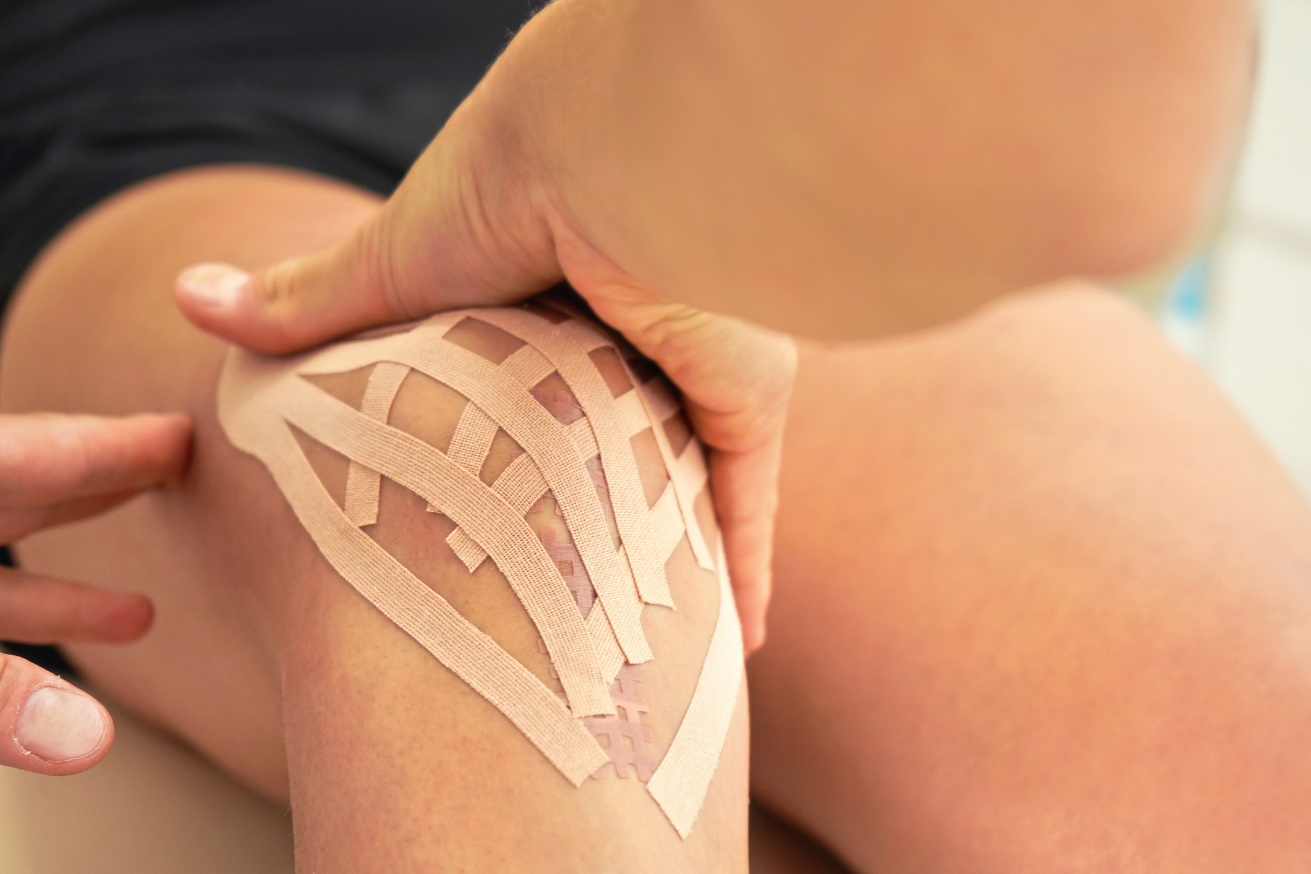- fyzioterapia.net - Physiotherapy in athletes using kinesiotaping. Author of the thesis: Ľubomír Mišút. PhDr. Eva Vaská. University of St. Cyril and Methodius in Trnava
- dspace.cuni.cz - Influence of kinesiotaping in lumbalgia. Author of the thesis.
- solen.cz - Kinesiotaping techniques in neurology - anatomical aspects. Solen. Mgr. Radka Filipčíková, Ph.D. and team of authors
- pubmed.ncbi.nlm.nih.gov - A systematic review of the effectiveness of kinesio taping for musculoskeletal injury. Mehran Mostafavifar, Jess Wertz, James Borchers
Kinesiotaping: taping with therapeutic tape. What are its therapeutic effects?

Taping, kinesiotaping, is a therapeutic method consisting of sticking special tapes on the surface of the body. It is mainly used by athletes, clients of rehabilitation facilities, but is increasingly popular among professionals and the general public. What exactly is kinesiotaping used for and what are its therapeutic effects?
Article content
The first knowledge of kinesiotaping in history
The first knowledge of kinesiotaping came from Japan. A chiropractor there was developing tapes that would help in healing and fixing a damaged muscle area.
The goal was a tape that would not reduce range of motion while stabilizing the segment. The tape's function was also to support the body's lymphatic and circulatory systems.
A Japanese chiropractor applied kinesiotaping to professional athletes on the national team.
The method was gradually introduced to the world from around 2004 during the Olympic Games in Athens.
What is kinesiotape?
The method of functional taping is based on the words kinesio (movement, musculoskeletal system) and tape. Worldwide, this method is known as kinesiotaping.
It is mainly used in physiotherapy and rehabilitation, but has also found a place in various medical fields such as orthopaedics, neurology, surgery, sports and aesthetic medicine.
Tape is an elastic adhesive tape that does not contain any harmful ingredients. The adhesive function is made possible by a medical grade acrylic adhesive. The tape is waterproof, wearable for several days even in the shower.
Long bathing is not recommended.
The tape is available in different colours, but this has little effect on the effect itself. The choice of the tape colour depends on the patient's preference, the (in)visibility of the tape, the colour of the sports jersey or psychologically it serves to express emotions with colours.
The effect of kinesiotaping
The tape is sewn on a cotton and acrylic backing, so it has elastic properties in the vertical direction but not in the transverse direction. Due to this differential force effect, elasticity and fixation occur simultaneously.
The skin lifts away from the underlying soft structures.
Simply put, by changing the position of the skin over the injured tissue (using tape), feedback is transmitted to the brain, the reflex response of which is adaptation and local change of the soft tissues.
The correct technique of tape application (extent of stretch, tension, direction and specific site of application) is important.
The application of tape has been shown to have beneficial effects on the soft structures of the body (skin, fascia, muscles, ligaments, joints and the human lymphatic and circulatory system).
Effects of functional kinesiotaping:
- Improvement of muscle function
- Effect on muscle tension
- Increase in muscle stability
- Promoting the healing process
- Supporting the lymphatic system
- Support the circulatory system
- Increase joint stability
- Elimination of the inflammatory process
- Reduction of swelling
- Reduction of local pain

Technique and principles of kinesiotap application
The therapeutic effect itself depends primarily on the method of application of the kinesiotape. Knowledge of the correct stretch, tension, direction and placement of the tape is necessary. Knowledge of the anatomy and muscle origins and tendons is required.
It is recommended that kinesiotape be applied by a professional who has completed a certified kinesiotaping course. If the tape is not properly stretched and directed, the desired therapeutic effects may not occur.
Conversely, in some cases of improper tape application, an undesirable effect may occur.
Techniques of kinesiotaping are professionally divided into:
- Mechanical - promoting segment fixation/stability and eliminating pain.
- Fascial - affecting muscle envelopes and soft structures
- Motion - eliminating pain and promoting the healing process
- Ligamentous - affecting proprioception and muscle tension
- Functional - affecting restriction and stability of segmental movement
- Lymphatic - promoting lymphatic drainage and the vascular system
Before the actual taping, the tape must first be measured and cut to the desired shape according to the goal of the therapy. The principle of taping is the initial disinfection and basic cleansing of the skin. The actual taping and untaping of the tape is not painful at all.
The tape lasts on the skin for an average of 3 days.
For hygienic reasons, it is not recommended to immediately reapply the tape to the same place. A 1-2 day break between each re-taping is recommended.
There are different types of kinesiotape shapes. V, I, Y, X or donut (wheel), mesh or fan. Y-shape taping is mainly used to affect a specific muscle.
The familiar riverbed-like shape of the taping is used primarily to promote lymphatic and vascular circulation - known as lymphatic taping.
Kinesiotaping can be applied to virtually any surface area on the patient's skin. In aesthetic medicine or in neurology for facial nerve disorders, kinesiotaping is also used in the facial area.

The most common indications for kinesotaping are:
- Muscle pain (myalgia).
- Overloaded muscles
- Muscle and movement imbalances
- Neuralgia
- Joint instability
- Vertebro-algic syndrome (back pain)
- Peripheral and central paresis
- Swelling
- Osteoarthritis
- Degenerative processes
- Insufficient lymphatic drainage
- Scar care
Contraindications to kinesiotaping:
- Open wounds
- Skin eruptions and dermatitis
- Unhealed scars
- Allergy to acrylic
- Acute thrombosis
- Melanoma of the skin
- Fragile skin
- Feverish conditions
Increased caution is required when evaluating the application of kinesiotap in persons diagnosed with diabetes mellitus (diabetes), cancer, and in pregnant women.
Kinesiotaping in practice
The method of taping functional tapes to the patient's body is of therapeutic and psychological importance in rehabilitation. Taping is used for a wide range of musculoskeletal diagnoses and is increasingly popular with clients.
Kinesiotaping is mainly used in physiotherapy to relax soft structures of overloaded muscles, to fix muscles for better segmental stability or to support the lymphatic system to reduce swelling.
It is part of preventive and post-operative rehabilitation.
Due to the advantages and minimal contraindications of the taping method, the basic course of kinesiotaping can be completed in most training centres even as a layman, i.e. without higher medical education.
Interesting resources
Related










